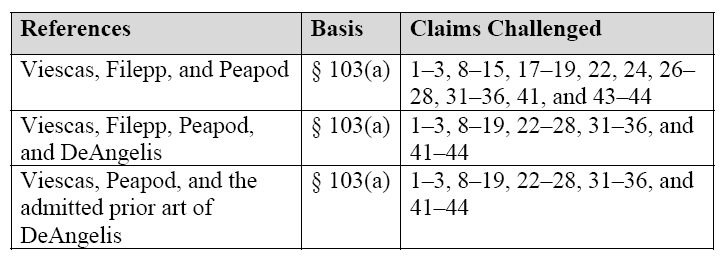Earlier this month we explored the Board’s discretionary power under 35 U.S.C. § 325(d) to deny a petition premised on prior art or arguments previously considered by the U.S. Patent and Trademark Office. Shortly after that blog post, the Board issued another decision illustrating its use of § 325(d) to deny institution of a review where petitioners seek a so-called “second bite at the apple.”
In Travelocity.com LP v. Cronos Technologies, LLC, the Board denied a Petition for Covered Business Method Review “[i]n view of the substantially similar arguments presented and the same references applied in an earlier Petition.” CBM2015-00047, Paper 7, 2 (PTAB June 15, 2015). Petitioners Travelocity, Priceline, and Expedia submitted a first petition for CBM review in March 2014. CBM2014-00082, Paper 1. This first petition asserted the following grounds of invalidity:
The first petition was denied in September 2014 when the Board found that the Petitioners had failed to establish that it was more likely than not that they would prevail in showing unpatentability of the challenged claims based on the Viescas and Peapod prior art, in combination with Filepp and/or DeAngelis. CBM2014-00082, Paper 10 (PTAB Sept. 15, 2014).
The Petitioners then filed a second petition which asserted the following grounds of invalidity:
Patent Owner Cronos Technologies filed a Preliminary Response arguing that the second petition should be denied under § 325(d) because it used the same prior art and presented substantially the same arguments as the first petition. CBM2015-00047, Paper 6. Although there are several differences in the asserted ground of invalidity, the Board dealt with each in turn and ultimately denied the second petition:
– Anticipation vs. Obviousness: Petitioners argued that the Peapod ground under § 102 amounted to a new ground of unpatentability. The Board disagreed, noting that the first petition had asserted that each of the Viescas, Filepp, and Peapod references “individually may render the claims unpatentable” even though the Petitioners only asserted the references in combination. Travelocity.com at 10 (emphasis added). The Board concluded that, rather than present different arguments, the Petitioners had “simply recast[] the facts in the context of the same legal arguments.” Id. at 11.
– Indefiniteness: The Board again relied on statements in the first petition to demonstrate that it had previously considered this line of argument. Notably, Petitioners argued in the first petition that the claim term “communications means” should be construed under 112(f) and that “to the extent that the claim can even be construed, the cited prior art teaches that all of the recited functions are performed…” Id. at 8, 12.
– New Claims: Although challenging new claims could circumvent § 325(d) by raising new arguments, the Board concluded in this case that the Petitioner failed to explain why the new claims were not challenged in the first petition and merely used the same references and arguments as in the first petition. Id. at 11-12.
In our previous post on this subject, we identified three general categories of cases where the PTAB has shown a willingness to use § 325(d): (1) preventing a second bite at the apple, (2) preventing duplicative proceedings, and (3) preventing unfair prejudice to a patent owner. The Travelocity.com decision falls squarely into the first category. In earlier decisions, the Board has explained its use of § 325(d) by citing a “concern[] about encouraging, unnecessarily, the filing of petitions which are partially inadequate.” ZTE Corp. v. ContentGuard Holdings, Inc., IPR2013-00454, Paper 12, 6 (PTAB Sept. 25, 2013) (informative opinion). In Travelocity.com, the Board struck a similar tone, noting “a decision on a petition for covered business method review is not simply part of a feedback loop by which a petitioner may perfect its challenges through a subsequent filing.” Travelocity.com at 13.
The Travelocity.com decision shows the importance for a petitioner to get the petition right the first time. The Board has shown a strong preference for denying second petitions which seek to make substantive corrections or improvements to previous petitions. This decision also cautions Petitioners against the use of superfluous language in the petition. In Travelocity.com, unnecessary language – such as a claim that references could anticipate a claim even when only obviousness challenges are brought or that a claim is likely indefinite when no indefiniteness challenge is brought – gave the Board a foothold for rejecting the second petition.


